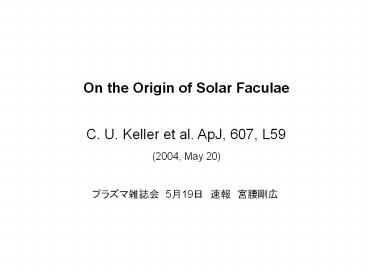On the Origin of Solar Faculae
1 / 7
Title: On the Origin of Solar Faculae
1
On the Origin of Solar Faculae
C. U. Keller et al. ApJ, 607, L59
(2004, May 20)
??????? 5?19? ?? ????
2
limb
Obs.
(Lites et al. 2004, in press)
three-dimensional simulations of nongray
radiative magnetoconvection in the solar
surface layers carried out with the MURaM code
extending 1400 km in the vertical direction
(roughly covering the range between 800 km
below to 600 km above the visible solar surface)
and 6000 km in both horizontal directions, with
grid spacings of 14 and 21 km, respectively
Simulation (400 G)
vertical magnetic field two cases 200 G and
400 G
snapshots taken after a statistically stationary
state of the simulated radiative
magnetoconvection had developed
Simulation (200 G)
heliocentric angle shita 60 and to a wavelength
of 488 nm, the same angle and wavelength at
which the observations by Lites et al. (2004)
3
Simulation (400 G case)
The horizontal axis gives the projected size in
arcseconds to facilitate the comparison with
observations.
In the vertical we show the model scale (in
kilometers). The model slice itself has been
skewed such that the lines of sight at shita 60
become vertical.
dashed lines at the geometrical heights at which
the integral of the continuum intensity
contribution function over optical depth reaches
10 and 90, respectively
Since the complete integral is equal to the
emerging intensity, 80 of the continuum
intensity originates from the area between the
dashed lines.
4
The opacity in the magnetic flux concentration is
strongly reduced owing to its low density and
low temperature and thus provides a clear sight
straight through the magnetic field onto the
adjacent nonmagnetic granule
The excess brightness of the faculae comes from a
thin layer, which is embedded in the steep
density gradient at the interface between the
magnetic and the nonmagnetic atmosphere
If the flux concentration is too small, the
opacity reduction that it produces is not
sufficient along the line of sight to have the
continuum intensity be formed almost exclusively
in the hot granule. The flux concentration to the
right of the facula in Figure 2 is an example of
this effect
5
faculae
dark lane
The temperature in this area is lower than the
average temperature stratification at equal
optical depth, explaining the brightness deficit
6
(No Transcript)
7
Despite the excellent qualitative agreement
between simulations and observations, there
remain quantitative disagreements such as the
peak brightness of faculae, which is
substantially larger in the simulations as
compared to the observations.
It also appears that there are more very small
brightenings in the observations as compared to
the simulations. Some of these differences are
certainly due to the conditions under which the
observations were recorded, which limit the
spatial resolution of the observations, reduce
the contrast due to scattered light, and may
generate small-scale features due to remaining
speckles. Some of the differences may also be
due to the limitations of our simulations such as
the restricted spatial sampling in faculae,
much of the continuum is formed over a range that
spans at most a few cells.































